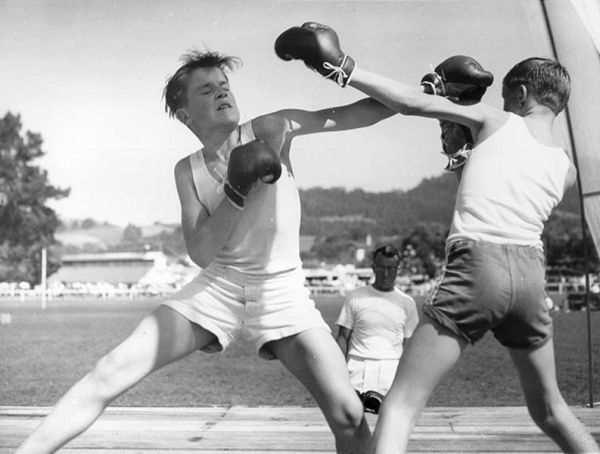 |
 |
|
Boxing
Boxing, though illegal, occurred throughout Tasmania's convict period, often at isolated places where large crowds enjoyed the accompanying drinking and gambling, and watched matches which could be lengthy – one in 1817 lasted 84 rounds. Boxing's popularity faded as respectability grew in the 1850s, but once Queensberry rules were adopted from the 1870s, it was seen as manly rather than disreputable, and new gymnasia encouraged it. It was not always so reputable: boxing became the favourite form of entertainment for west coast miners, with many title fights held at Zeehan's Gaiety Theatre. Even in Hobart, police tried to stop a fight held in a packed Theatre Royal in 1909. Amateur boxing championships were held in Hobart, and in 1909 the Tasmanian amateur middleweight champion, Reg Midwood, won the Australian title. Professional boxing was particularly popular during the Depression, as income from fights could help the family budget. During the 1920s and 1930s some Tasmanians won national titles, and welterweight Bill Smith, aged eighteen, won a gold medal at the Empire Games in 1938. Boxing remained popular in the 1950s and 1960s, with professional fights at Hobart's City Hall, and many boxers emerging from the west coast. Travelling showman Harry Paulsen set up his tent at country shows, spruiking through his megaphone to tempt red-blooded locals into the ring to fight his boxers, and maybe earn a few bob. Tasmanian boxers enjoyed a high reputation, with nine national title winners, and three Olympians, Ron Gower, Gerald Freeman and Wayne Devlin, between 1948 and 1976. Professional boxing lapsed in the 1970s, but amateur boxing remained popular; 1990s Olympians were Justann Crawford and Daniel Geale. Further reading: D Young, Sporting Island, Hobart, 2005. Alison Alexander and David Young
|
Copyright 2006, Centre for Tasmanian Historical Studies |
